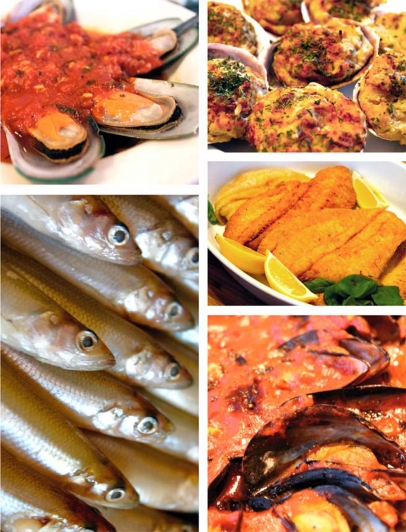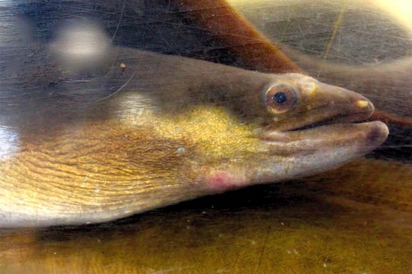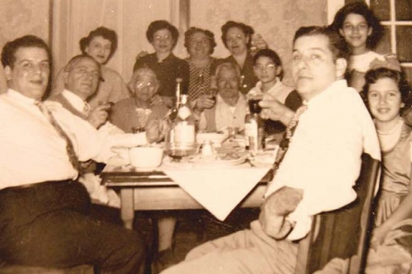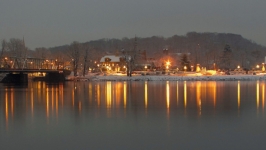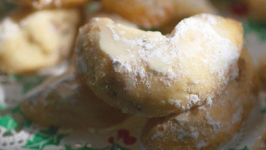Feast of the Seven Fishes
For many Italian-American families in New Jersey, Christmas Eve means seafood. Every year in mid-December, family cooks from Bayonne to Bellmawr start to count fishes, making sure that the holiday menu includes at least seven different kinds.
The traditional meal called the “Feast of the Seven Fishes” has its roots in Southern Italy, where observant Roman Catholics abstained from eating meat on Fridays and on the day before holy days like Christmas. On Christmas Eve, the traditional supper was exclusively seafood, usually fried in oil. Fish is also associated with early Christians, who used a fish symbol to identify themselves in times of persecution. The significance of the number seven?
Religious interpretations point to the seven sacraments of the Roman Catholic Church, the seven virtues in the Catholic catechism, and Biblical references like God resting on the seventh day. The number could also refer to the Seven Hills of Rome, or just be a lucky number. Some families feature nine, 11 or even 13 fishes in their annual meal. Why seven “fishes” rather than seven “fish”? The “seven” means seven different species of fi sh. The great Italian migration to the United States between the 1880s and the 1930s brought thousands of Southern Italians to the Northeast, my own ancestors among them. Their seafood feast came with them.
My mother remembers Christmas Eve meals in the 1950s at her grandmother’s house on Third Street in South Orange. Antoinette Verducci, the Italian-born matriarch from Calabria, prepared the meal, which always included baccalà (salt cod), mussels in a spicy marinara sauce, fried smelts, and pastas with seafood sauces. The annual spread also included pizza fritta (fried dough) served with tomato sauce and zeppole (deep-fried dough balls) with powdered sugar, the highlight of the meal for my mom and her cousins. Mom avoided the smelts, a tiny fish caught in coastal estuaries.
The Italian tradition of the Feast of the Seven Fishes lives on in New Jersey, and seems to have become more popular, or at least better remembered, in recent years. Restaurants across the Garden State have begun to offer the traditional Christmas Eve seafood feast in December. Younger generations are counting their fishes and rediscovering some of the seafood dishes prepared by the fi rst generation Italian-Americans.
Italian cooking relies on fresh, local ingredients. For immigrant families with limited resources, the seafood selections in New Jersey were not fancy. Like all good cooks, Italian-Americans took what was cheap and abundant, applied familiar techniques and recipes from back home, and transformed simple food into memorable meals.
For decades, preparations for the feast have begun at the local Jersey fi sh market. Barbera Fish Market in Atlantic City has been selling the fi sh for South Jersey Italian feasts since 1919.
Dominic Alcaro, who bought the market in 1985, is a first-generation immigrant himself. His parents emigrated from Calabria in 1961 when he was six years old. Dominic still remembers his grandfather walking back from the Italian waterfront with eels, cuttlefish and whiting for the Christmas Eve meal.
Today, Barbera Fish Market sells some of the same fi sh species in New Jersey, but the most popular Seven Fishes have changed over the years. The fish market’s older customers order eel, baccalà, octopus and calamari to serve on Christmas Eve; younger customers prefer shrimp, flounder and sea bass.
Every family’s fishes are different, but Garden State menus usually include a few of the Italian-American red-sauce standbys like baccalà in tomato sauce, mussels in a spicy marinara sauce and fried calamari. My grandfather insisted that fried smelts be on the table every year. Really old-school families still serve eel stewed in tomato sauce.
And despite renewed interest in the feast by a number of New Jersey restaurants, Alcaro sees the feast continuing to be “mostly a home holiday.” Alcaro’s parents continued making the traditional meal in the United States, and now he is doing the same. After the last customer picks up the last holiday fi sh order from Barbera Fish Market, he hosts some 50 family members at his home in Gloucester, Camden County. His menu sticks to seven fi shes, but he prepares each fish several different ways for a total of 15 to 20 fi sh dishes on the table. Baccalà salad and stew are popular in his family. Alcaro not only fries his smelts—the “easy way,” he points out—but also sautés them with tomatoes, olive oil, garlic and onion.
After feasting on all that seafood, Alcaro’s family gathers around an elaborate nativity scene adorned with figurines carved by his father. They sing Italian Christmas songs (like Tu scendi dalle stele—“You Come Down from the Stars”), and the youngest family member places the baby Jesus in the manger at midnight. “The Feast of the Seven Fishes is all about sacrifi ce and giving thanks,” says Alcaro. “It’s wonderful to see the Italian family tradition live on.”
FEAST OF THE SEVEN FISHES
MENUS
Old-School
Scungilli salad
Mussels in spicy marinara sauce
Fried smelts
Flounder fillet
Linguine with red clam sauce
Baccalà (salt cod) in tomato sauce
Eel stewed in tomato sauce
Updated
Shrimp cocktail
Clams oreganata
Fried calamari with marinara sauce
Zuppa di pesce (fish soup)
Seared scallops
Lobster fra diavalo over linguini
Whole grilled branzino (sea bass)


